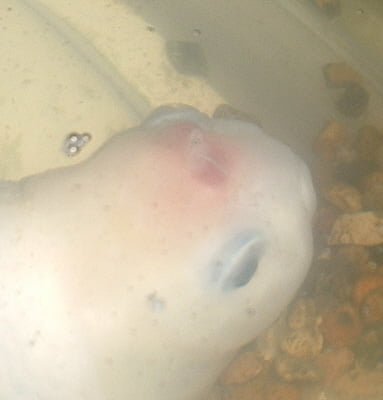Bacteria friend or foe? learn the difference
Buy the Book
Bacteria friend or foe? There are two kinds of bacteria; harmful and beneficial bacteria. Where you find healthy colonies of friendly bacteria, you’ll find very little unfriendly bacteria and vice versa. Goldfish and beneficial bacteria alike prefer the very same water conditions. Friendly bacteria thrive in heavily oxygenated water, preferring cooler water temperatures
The comfort zone is 64 to 74f, however, these friendly bugs cannot tolerate light. Beneficial bacteria prefer building colonies in our pumps and filters where they have total darkness and water with high oxygen levels
Symptoms of bacteria infection include, torn or frayed fins, missing scales and hole in head. Sores, ulcers and fungus present on mouth or body are other symptoms. Film or mucus on body, cotton like fungus are also symptoms. Goldfish pooh is very light pooh or very dark pooh and stringy indicate infection of the tract. White cloud in water is a bad bacteria bloom
Beneficial bacteria has a woodsy smell that doesn’t offend the nose, while harmful bacteria has a foul odor
Friendly bugs
Nitrites and nitrates are created by living organisms. When you feed your goldfish, you’re also feeding your friendly bugs
Healthy amounts of ammonia must be present in order for friendly bugs to reproduce successfully. One small fish in a large tank may not produce enough waste to create a healthy colony of beneficial bacteria
Unfriendly bacteria is present in many forms waiting for a chance to multiply. Bad bugs will have a difficult time becoming established in a healthy ecosystem. Harmful bacteria prefer warmer water temperatures and stagnant or slow moving water. Harmful bacteria thrive in low levels of oxygen
Which kind of bacteria will your ecosystem attract?
Don’t make the mistake of treating with a medicinal antibiotic if your fish house is infected. Medications weaken fish, pushing them farther away from good health. Made up of harsh chemicals, pet shop medications kill unfriendly bacteria and friendly bacteria alike
Unfriendly bugs
Antibiotics will not correct the real problem. The only way to keep unfriendly bacteria levels low in your goldfish tank or pond is to encourage friendly bacteria. Provide a proper breeding ground and a healthy environment. Oxygenated water is the key to excellent goldfish and beneficial bacteria health. Increase the surface action and you’ll also increase the oxygen levels. O2 destroys bad bacteria on contact
Bacteria friend or foe
Add a pond pump to your set up. Only a real pond pump provides the right type of action to clear the body of water so that oxygen can enter. Read about oxygenating the water in your tank or pond Oxygenating Water
Make sure there’s plenty of fresh air in the room where your aquarium is located. Open a window. Keep the air moving to assure Co2 (carbon dioxide) doesn’t rest heavily over the surface of your tank, blocking fresh air from water. Point a fan at the tank so it skims across the surface
Harmful bacteria multiply or split; every 20 to 30 minutes, whereas; beneficial bacteria multiply every 10 to 20 hrs
Beneficial bacteria
Remove the top of your tank if enclosed. The water surface must be exposed to fresh air. Enclosed tanks deplete water of oxygen levels. Increased amounts of carbon dioxide in the water suffocate goldfish. Oxygen is absorbed from the surface by method of diffusion
Bubblers or air pumps do not oxygenate water
Bacteria friend or foe
The perfect breeding ground for harmful bacteria is beneath thick layers of gravel or decorations provide . Keep layers at a maximum of 1/2″ so goldfish can easily stir up the gravel. Avoid the use of sand in aquariums or ponds. Sand irritates the gills of goldfish and provides bad bugs the perfect spot to hide. Lift the pots and vacuum beneath them if your fish house is planted. Your fish will eventually become infected externally and, or internally if the waste is infected
Feed a healthy and varied diet. A slow moving tract invites bad bacteria
Harmful bacteria
This fish in the photo below is suffering from a serious infection often referred to as hole in the head, caused by bad bacteria. The abscess you see will increase in size, and depth, eventually boring down to the brain, killing the fish

Use a gravel vacuum with your weekly water changes to reduce harmful bacteria hiding in substrate
Never fast your fish; when you do, you’re also starving your friendly bugs, and opening the door to sinking issues. Fish need waste in the tract at all times because it creates Co2. Connected to the intestines, the swim bladder organ uses carbon dioxide to function. Learn more Floating and Sinking issues
Bacteria friend or foe
In order for your fish house water to support oxygen, the water must have a healthy pH. A combined reading for oxygen and KH, pH tells the story. Test carbonate mineral (KH) first and foremost, making certain it’s at a healthy level. KH comfort zone is 70 to 120 ppm and pH comfort zone is 7.4 to 8.4 ppm with the higher side of the zone being preferred
If KH is at a healthy reading, but pH is low, use Oop Boost to increase oxygen levels
Prevention is the best medicine. Treat your fish house to a remedy or tonic periodically
Use the ‘Salt Treatment’ combined with ‘Garlic Treatment’ to eliminate harmful bacteria infection
Stagnant water; which is low in oxygen levels, encourage bad bacteria. Get your tank water moving and lower water temperature to assure your tank or pond has the good kind of bacteria
Copyright 2008
Author: Brenda Rand